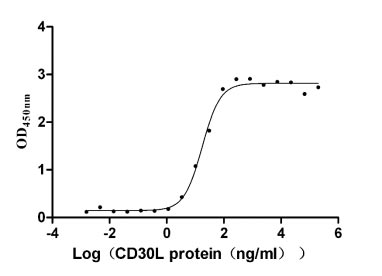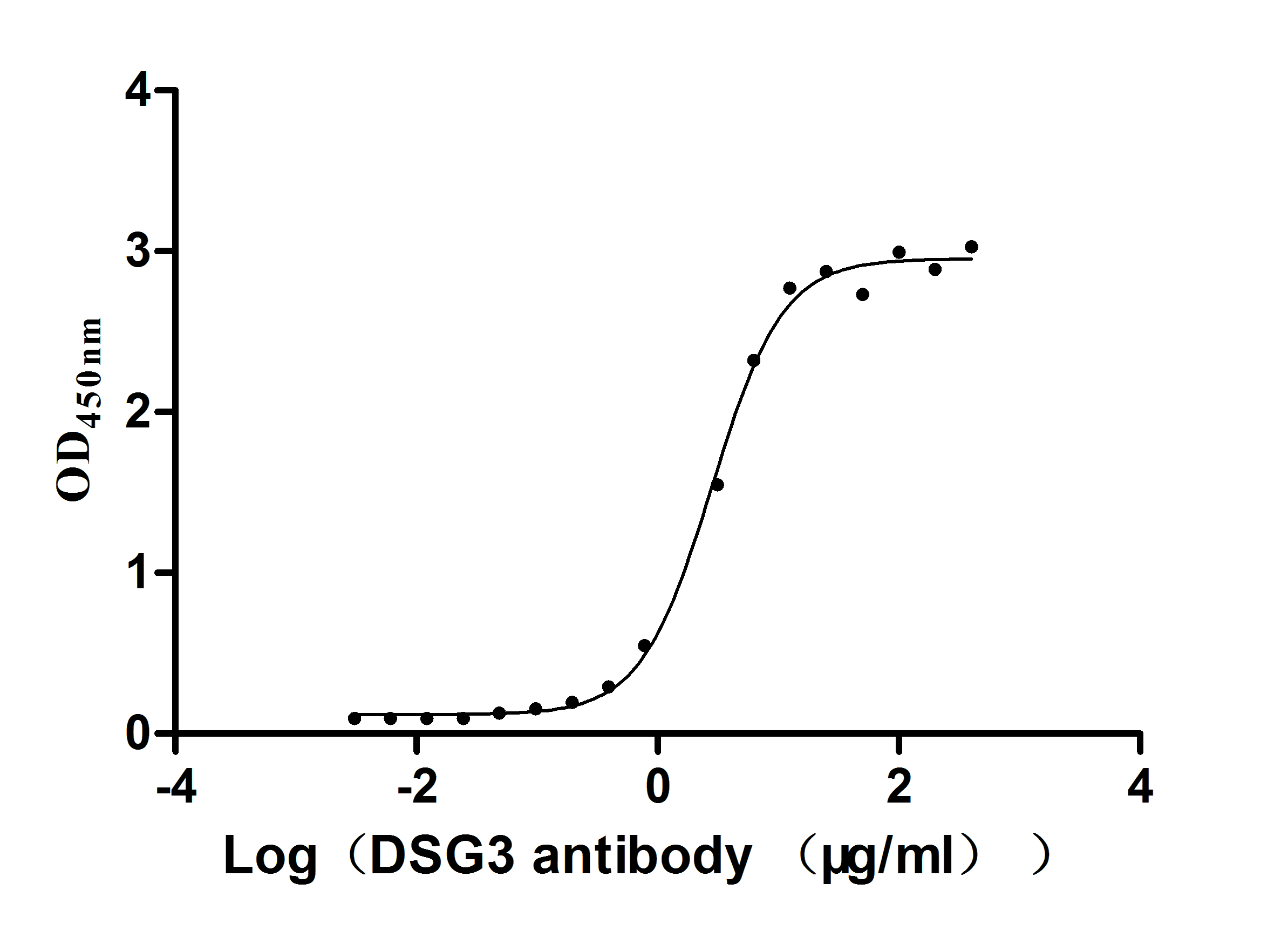Recombinant Human cGMP-dependent protein kinase 2 (PRKG2)
-
货号:CSB-YP614401HU
-
规格:
-
来源:Yeast
-
其他:
-
货号:CSB-EP614401HU
-
规格:
-
来源:E.coli
-
其他:
-
货号:CSB-EP614401HU-B
-
规格:
-
来源:E.coli
-
共轭:Avi-tag Biotinylated
E. coli biotin ligase (BirA) is highly specific in covalently attaching biotin to the 15 amino acid AviTag peptide. This recombinant protein was biotinylated in vivo by AviTag-BirA technology, which method is BriA catalyzes amide linkage between the biotin and the specific lysine of the AviTag.
-
其他:
-
货号:CSB-BP614401HU
-
规格:
-
来源:Baculovirus
-
其他:
-
货号:CSB-MP614401HU
-
规格:
-
来源:Mammalian cell
-
其他:
产品详情
-
纯度:>85% (SDS-PAGE)
-
基因名:
-
Uniprot No.:
-
别名:CGK 2; cGK2; cGKII; cGMP dependent protein kinase 2; cGMP-dependent protein kinase 2; cGMP-dependent protein kinase II; KGP2_HUMAN; PRKG 2; PRKG2; PRKGR2; Protein kinase; cGMP dependent; type II; Type II cGMP dependent protein kinase
-
种属:Homo sapiens (Human)
-
蛋白长度:Full Length of Mature Protein
-
表达区域:2-762
-
氨基酸序列GNGSVKPKH SKHPDGHSGN LTTDALRNKV TELERELRRK DAEIQEREYH LKELREQLSK QTVAIAELTE ELQNKCIQLN KLQDVVHMQG GSPLQASPDK VPLEVHRKTS GLVSLHSRRG AKAGVSAEPT TRTYDLNKPP EFSFEKARVR KDSSEKKLIT DALNKNQFLK RLDPQQIKDM VECMYGRNYQ QGSYIIKQGE PGNHIFVLAE GRLEVFQGEK LLSSIPMWTT FGELAILYNC TRTASVKAIT NVKTWALDRE VFQNIMRRTA QARDEQYRNF LRSVSLLKNL PEDKLTKIID CLEVEYYDKG DYIIREGEEG STFFILAKGK VKVTQSTEGH DQPQLIKTLQ KGEYFGEKAL ISDDVRSANI IAEENDVACL VIDRETFNQT VGTFEELQKY LEGYVANLNR DDEKRHAKRS MSNWKLSKAL SLEMIQLKEK VARFSSSSPF QNLEIIATLG VGGFGRVELV KVKNENVAFA MKCIRKKHIV DTKQQEHVYS EKRILEELCS PFIVKLYRTF KDNKYVYMLL EACLGGELWS ILRDRGSFDE PTSKFCVACV TEAFDYLHRL GIIYRDLKPE NLILDAEGYL KLVDFGFAKK IGSGQKTWTF CGTPEYVAPE VILNKGHDFS VDFWSLGILV YELLTGNPPF SGVDQMMTYN LILKGIEKMD FPRKITRRPE DLIRRLCRQN PTERLGNLKN GINDIKKHRW LNGFNWEGLK ARSLPSPLQR ELKGPIDHSY FDKYPPEKGM PPDELSGWDK DF
-
蛋白标签:Tag type will be determined during the manufacturing process.
The tag type will be determined during production process. If you have specified tag type, please tell us and we will develop the specified tag preferentially. -
产品提供形式:Lyophilized powder
Note: We will preferentially ship the format that we have in stock, however, if you have any special requirement for the format, please remark your requirement when placing the order, we will prepare according to your demand. -
复溶:We recommend that this vial be briefly centrifuged prior to opening to bring the contents to the bottom. Please reconstitute protein in deionized sterile water to a concentration of 0.1-1.0 mg/mL.We recommend to add 5-50% of glycerol (final concentration) and aliquot for long-term storage at -20℃/-80℃. Our default final concentration of glycerol is 50%. Customers could use it as reference.
-
储存条件:Store at -20°C/-80°C upon receipt, aliquoting is necessary for mutiple use. Avoid repeated freeze-thaw cycles.
-
保质期:The shelf life is related to many factors, storage state, buffer ingredients, storage temperature and the stability of the protein itself.
Generally, the shelf life of liquid form is 6 months at -20°C/-80°C. The shelf life of lyophilized form is 12 months at -20°C/-80°C. -
货期:Delivery time may differ from different purchasing way or location, please kindly consult your local distributors for specific delivery time.Note: All of our proteins are default shipped with normal blue ice packs, if you request to ship with dry ice, please communicate with us in advance and extra fees will be charged.
-
注意事项:Repeated freezing and thawing is not recommended. Store working aliquots at 4°C for up to one week.
-
Datasheet :Please contact us to get it.
相关产品
靶点详情
-
功能:Crucial regulator of intestinal secretion and bone growth. Phosphorylates and activates CFTR on the plasma membrane. Plays a key role in intestinal secretion by regulating cGMP-dependent translocation of CFTR in jejunum. Acts downstream of NMDAR to activate the plasma membrane accumulation of GRIA1/GLUR1 in synapse and increase synaptic plasticity. Phosphorylates GRIA1/GLUR1 at Ser-863. Acts as regulator of gene expression and activator of the extracellular signal-regulated kinases MAPK3/ERK1 and MAPK1/ERK2 in mechanically stimulated osteoblasts. Under fluid shear stress, mediates ERK activation and subsequent induction of FOS, FOSL1/FRA1, FOSL2/FRA2 and FOSB that play a key role in the osteoblast anabolic response to mechanical stimulation.
-
基因功能参考文献:
- L-Arginine is a potential alternative to PKG II activation. PMID: 29401205
- Comparative analysis of the backbone hydrogen/deuterium exchange patterns in PKG II:8-pCPT-cGMP and previously reported PKG Ibeta:cGMP XN structures suggests that the ability of these agonists to activate PKG is related to how effectively they quench dynamics of the cyclic nucleotide binding pocket and the surrounding regions. PMID: 29517905
- the results indicated that PKG II could block c-Met activation via phosphorylating Ser985 PMID: 27147579
- PKG II inhibits EGFinduced activation of HER2 through binding with and causing threonine 686 phosphorylation of this oncogenic protein. PMID: 26676300
- The C-terminal cyclic nucleotide binding (CNB-B) domain of cGMP-dependent protein kinase II binds cGMP with higher affinity and selectivity when compared with its N-terminal CNB (CNB-A) domain. PMID: 26769964
- Han Chinese patients with rs10033237 polymorphism of cGKII/PRKG2 gene are more likely to suffer from gout. PMID: 25688884
- Our replication study suggests that cGKII is not involved in gout susceptibility. PMID: 24882840
- we determined a crystal structure of the PKG II LZ-Rab11b complex. The PKG II LZ domain presents a mostly nonpolar surface onto which Rab11b docks, through van der Waals interactions PMID: 25070890
- PKGII inhibits RhoA activity by binding to this small GTPase and causing phosphorylation at its Ser188 site. PMID: 24549567
- PKG II also inhibits the activation of the EGFR caused by diverse ligands of the receptor. PMID: 24534906
- type II cGMPdependent protein kinase prevented the EGF-induced phosphorylation/activation of ERK and JNK, but not the phosphorylation of p38MAPK induced by EGF. PMID: 22940826
- Downregulation of PKG2 was associated with malignant and benign breast tumors. PMID: 22791569
- The work presented here demonstrates a novel antiproliferative and prodifferentiation role for PKG2 in the colon. PMID: 22556146
- The results suggest that PKGII inhibits EGF-induced MAPK/JNK-mediated signal transduction and further confirmed that PKGII can block the activation of EGFR. PMID: 22427012
- PKG II inhibits the proliferation of gastric cancer cells through blocking EGF-triggered MAPK signal transduction. PMID: 22012247
- As an addition to PRKG2 and RASGEFIB genes, we propose to include BMP3 gene as the principal determinant of the observed common phenotype. PMID: 22303795
- Inhibition of cGMP-dependent protein kinase II by its own splice isoform PMID: 12054676
- results show that the fast phase of autophosphorylation of cGMP dependent protein kinase II has a small effect on its activity, whereas the secondary phase involving Ser126 phosphorylation may generate an active form PMID: 12764134
- Characterization of the 4q21 breakpoint revealed PRKG2 as the likely gene partner to PDGFRB in myeloproliferative disorders. PMID: 18262053
- Results suggest that the cGK II gene on chromosome 4q21 is most likely to harbour gout disease independently of hyperuricaemia and is inherited recessively. PMID: 18678579
- Regulation of epithelial sodium channels by cGMP/PKGII. PMID: 19359370
- PRKG2 inhibits cell proliferation, Sox9 expression and Akt phosphorylation in human glioma cell lines. PMID: 19543319
显示更多
收起更多
-
亚细胞定位:Apical cell membrane; Lipid-anchor.
-
蛋白家族:Protein kinase superfamily, AGC Ser/Thr protein kinase family, cGMP subfamily
-
组织特异性:Highly concentrated in brain, lung and intestinal mucosa.
-
数据库链接:
HGNC: 9416
OMIM: 601591
KEGG: hsa:5593
STRING: 9606.ENSP00000264399
UniGene: Hs.232044
Most popular with customers
-
Recombinant Human Tumor necrosis factor receptor superfamily member 8 (TNFRSF8), partial (Active)
Express system: Mammalian cell
Species: Homo sapiens (Human)
-
Recombinant Mouse Desmoglein-3 (Dsg3), partial (Active)
Express system: Mammalian cell
Species: Mus musculus (Mouse)
-
Recombinant Mouse Prolactin receptor (Prlr), partial (Active)
Express system: Mammalian cell
Species: Mus musculus (Mouse)
-
Recombinant Human Intestinal-type alkaline phosphatase (ALPI) (Active)
Express system: Mammalian cell
Species: Homo sapiens (Human)
-
Recombinant Human Claudin-4 (CLDN4)-VLPs (Active)
Express system: Mammalian cell
Species: Homo sapiens (Human)
-
Recombinant Macaca fascicularis CD93 molecule (CD93), partial (Active)
Express system: Mammalian cell
Species: Macaca fascicularis (Crab-eating macaque) (Cynomolgus monkey)
-
Recombinant Human Oncostatin-M (OSM), partial (Active)
Express system: Mammalian cell
Species: Homo sapiens (Human)
-
Recombinant Human C-C chemokine receptor type 6(CCR6)-VLPs (Active)
Express system: Mammalian cell
Species: Homo sapiens (Human)




















